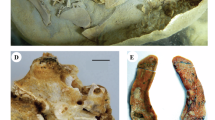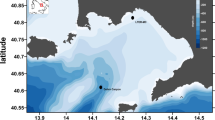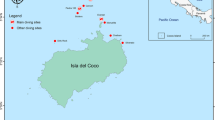Abstract
Coelacanths are arguably one of the most emblematic and evolutionarily-important of the marine vertebrates. To date, only two species are known globally: the West Indian Ocean Coelacanth, Latimeria chalumnae, found in the Mozambique Channel, from Southern Africa to Comoro Islands, and the Sulawesi Coelacanth, L. menadoensis, found off Sulawesi and Western New Guinea in Indonesia. The latter species has been much less documented than its African congener, and due to the difficulty of reaching the deep-reef habitats it lives in, very few in situ observations were made, and only from submersibles or Remotely Operated Vehicles. We report here the first observations of an adult coelacanth in the North Maluku Province of Indonesia and the first in situ images taken by divers of an Indonesian coelacanth, after successfully identifying suitable ecosystems during previous deep technical dives. This discovery contributes to our understanding of the biogeography and ecology of this vulnerable species and provides additional insights about its natural behaviour. Ultimately, we expect this work to help addressing coelacanth conservation in Indonesia, in an international context of dramatic biodiversity decline and natural ecosystems destruction.
Similar content being viewed by others
Introduction
The Sulawesi Coelacanth (Latimeria menadoensis) is a rarely-documented, moderate deep-water lobe-finned fish (non-tetrapod sarcopterygian) initially thought to be endemic to the Sulawesi region of Indonesia and known primarily from bycatch1. Very few direct in situ observations have been made of this species, and only using submersibles and Remotely Operated Vehicles (ROVs)2,3. Here we report the first direct in situ sightings by divers of a live specimen of L. menadoensis in the waters of North Maluku, Indonesia, during recent reconnaissance technical dives exceeding 150 m depth to investigate suspected coelacanth habitats. This first wild encounter in a region where no coelacanth has been previously reported marks a pivotal step in efforts to understand the biogeography, natural behaviour and habitat of this enigmatic species, providing a foundation for advancing ecological studies of coelacanths and urgently protecting their vulnerable deep-reef habitats.
Today, all known coelacanth populations are under anthropogenic pressure globally4,5, and new threats may well arise in the near future with the development of potentially lucrative and unregulated coelacanth tourism activities. As long-lived species with a low metabolic rate, late sexual maturity and long gestation period, coelacanths are especially sensitive to any external perturbations6. Therefore, to protect a potential new population of the vulnerable L. menadoensis from disturbance, the exact locality of this discovery has been withheld until further studies are conducted and better protections are in place.
During a morning deep dive in October 2024 using closed-circuit rebreathers and trimix breathing gases, the first and seventh authors (Chappuis and Leblond) descended along a steep volcanic slope until they stopped at a maximum depth of 125 m. The complexity of the habitat structure and the sighting of an even more complex topography 20 m below encouraged the two divers to come back to perform a deeper dive. Indeed, based on the scientific literature documenting coelacanth habitats both in the West Indian Ocean and Indonesia, this site appeared to be the perfect matching environment, with consistent temperatures below 21 °C, and with steep slopes and the presence of numerous large cracks and crevices3,7.
During the second dive, two days later, both divers reached a maximum depth of 152 m, though the steep slope continued into the depths. The water temperature was 19–20 °C, significantly colder than the surface waters of 29–30 °C. At depth, the horizontal visibility was 30 m+, with low turbidity and current. The topography of the deep-reef habitat was highly complex, comprised of steep slopes, nearly vertical walls, numerous cracks (sometimes wide enough to host multiple large actinopterygian fish), overhangs and accumulations of large volcanic rocks. Fish abundance appeared to be low at the maximum depth, confirmed by images that recorded only a few fish species, notably the Checked Swallowtail, Odontanthias borbonius. However, the benthos consisted of a rich assemblage of sponges, soft corals and antipatharians densely covering all rocks.
After a few moments spent at -152 m, both divers started their ascent back to the surface with the plan of stopping along the way to document different levels of the mesophotic ecosystem, before entering the long decompression phase. The chance discovery of a coelacanth happened at -144 m, 9 AM local time. The animal, estimated to be about 1.1 m TL, was gently hovering above a large rock located on the slope and covered with benthic fauna, mainly sponges and soft corals (Figure 1).
Interestingly, it was out in the open, not inside a cave or under an overhang, which have long been considered coelacanths’ diurnal hides7. This corroborates the observations made by Iwata et al. during their field surveys in Indonesia, where coelacanths were not always found inside caves3. When the observation was made, the animal already had its dorsal fin completely erect and kept it like this all the time, which could be associated with an active state or potentially a natural defensive behaviour8. It was independently moving its second dorsal, anal and pectoral fins both to maintain its position and to slowly move in the water. Its pelvic fins were also used, though to a lesser extent. During the observation, the coelacanth slowly swam around the large rock, without any sudden movements. The first author took a few high-resolution pictures before having to continue the long ascent back to the surface through strong and changing near-surface currents.
In the morning of the next day, the two deep divers returned to the same site. At about 09:45 AM, they found the same coelacanth at a depth of -140 m, on the slope, just a few metres above the large rock of the previous day. Indeed, thanks to the photos and the unique colour pattern of each coelacanth7, it was possible to confirm that this was the same individual (Figs. 2 and 3). Again, its first dorsal fin was fully erect.
In situ photographs of the coelacanth encountered on two consecutive days in North Maluku, Indonesia (© Alexis Chappuis). First photo (left) was taken at -144 m, on Day 1, and second photo (right) at -134 m, on Day 2. The identical colour pattern of white dots laterally on the fish in both images confirm it is the same individual.
The encounters lasted about five minutes for the first one and eight minutes for the second, before the divers had to start making their way up to the surface. A fourth dive was conducted on the same site the following day, but no coelacanth was spotted this time. On each of the occasions, water temperature, current and visibility were observed to be similar.
The Sulawesi Coelacanth was officially discovered by Arnaz and Mark Erdmann in 1997 at a fish market in Manado, in North Sulawesi1. In 1999, it was described as a new species, distinct from its African congener, L. chalumnae9. Since then, investigations among local fishermen and scientific surveys with submersibles and ROVs have been conducted in North Sulawesi, eventually leading to new sightings, including of a juvenile in 20092,3,10,11. In addition, five specimens were observed during ROV surveys in the Province of Papua, on the western tip of the island of New Guinea3, and an individual accidentally caught off Waigeo Island might represent a genetically distinct population (Fig. 4)12.
To the best of the authors’ knowledge, no coelacanth sighting has been reported in the Maluku archipelago, making these unique observations essential in understanding the ecology and distribution of coelacanths throughout Indonesia.
Localities from whence the Sulawesi Coelacanth, Latimeria menadoensis, has been reported (modified from Fricke et al. 2000, Iwata et al. 2019 and Kadarusman et al. 2020). Black stars represent coelacanths observed from either ROV & submersible surveys or accidentally caught by fishermen. It includes Manado Tua Island, where L. menadoensis has been first discovered in 1997 (Erdmann et al. 1998). White star shows the North Maluku Province, where the first in situ sighting by technical divers was made (this paper).
It is too early to discuss a new Malukan coelacanth population. Still, since the Maluku archipelago is located between Sulawesi and Western New Guinea, it is unlikely that only one individual lives in this broad region. Our recent sightings, combined with the work we have conducted on mesophotic coral ecosystems of the Maluku archipelago since 2022, not only confirm the presence of Latimeria but also, more widely, the existence of suitable coelacanth habitats. This is good news for the conservation of this highly vulnerable vertebrate and supports the hypothesis that Indonesian coelacanths might present a more extensive distribution range than initially thought. It also highlights the importance of Eastern Indonesian waters as a marine biodiversity hotspot and reminds us of the necessity of protecting deep-reef ecosystems from human activity, as they host endemic, sensitive and threatened species. We also demonstrate here that it is possible to use technical diving to conduct non-invasive research on Indonesian coelacanths. For example, in the future, it should be possible to collect in situ DNA samples from living specimens without having to harm or catch them, which would provide critical information about the nature, composition and repartition of Latimeria across Indonesia. In addition, assessing the number of individuals present in North Maluku and their movements would help better understand the status of this putative new population and the ecological and behavioural traits of Indonesian coelacanths, and allow us to propose adequate and bold conservation measures to protect them13.
Meanwhile, we hope this discovery will encourage local and national authorities to increase conservation efforts in this vibrant and biodiverse region, which is now confirmed to be hosting one of the most elusive and emblematic marine species found in Indonesian waters.
Data availability
All data generated or analysed during this study are included in this published article.
References
Erdmann, M. V., Caldwell, R. L. & Moosa, M. K. Indonesian ‘king of the sea’ discovered. Nature 395, 335–335 (1998).
Fricke, H. et al. Biogeography of the Indonesian coelacanths. Nature 403, 38–38 (2000).
Iwata, M. et al. Field surveys on the Indonesian coelacanth, Latimeria menadoensis using remotely operated vehicles from 2005 to 2015. Bull. Kitakyushu Museum Nat. History Hum. History Ser. A. 17, 49–56 (2019).
Fricke, H., Hissmann, K., Schauer, J. & Plante, R. Yet more danger for coelacanths. Nature 374, 314–314 (1995).
Falahudin, D. et al. First insight into accumulation of characteristics and tissue distribution of PCBs, PBDEs, and other BFRs in the living Indonesian coelacanth (Latimeria menadoensis). Environ. Sci. Pollut. Res. 30, 49368–49380 (2023).
Mahé, K., Ernande, B. & Herbin, M. New scale analyses reveal centenarian African coelacanths. Curr. Biol. 31, 3621–3628e4 (2021).
Fricke, H. et al. Habitat and population size of the coelacanth Latimeria chalumnae at Grand Comoro. Environ. Biol. Fish. 32, 287–300 (1991).
Sakaue, J. et al. New insights about the behavioral ecology of the coelacanth Latimeria chalumnae video recorded in the absence of humans off South Africa. Front. Mar. Sci. 8, 755275 (2021).
Pouyaud, L. et al. Une nouvelle espèce de cœlacanthe. Preuves génétiques et morphologiques. Comptes Rendus de l’Académie des Sciences - Series III - Sci. de la. Vie. 322, 261–267 (1999).
Erdmann, M. V., Caldwell, R. L., Jewett, S. L. & Tjakrawidjaja, A. The second recorded living coelacanth from North Sulawesi. Environ. Biol. Fish. 54, 445–451 (1999).
Iwata, M. et al. Observation of the first juvenile Indonesian coelacanth, Latimeria menadoensis from Indonesian waters with a comparison to embryos of Latimeria chalumnae. Bull. Kitakyushu Museum Nat. History Hum. History Ser. A. 17, 57–65 (2019).
Kadarusman et al. A thirteen-million-year divergence between two lineages of Indonesian coelacanths. Sci. Rep. 10, 192 (2020).
Erdmann, M. Lessons learned from the conservation campaign for the Indonesian coelacanth, Latimeria menadoensis. South Afr. J. Sci. 102, 501–504 (2006).
Acknowledgements
The authors would like to thank BRIN for their support in issuing the necessary permit to conduct our research on mesophotic coral ecosystems in Indonesia, all the local communities we met and worked with along the way, and the team members (Fajrin, Jefry, Yus Rizal, Gonzalo, Arnaud, Zainal, Cilun, James, Yediael) and technical partners involved, with a special mention to Priska Widyastuti for her great help, support and expertise. We are grateful to Corry Manullang from the BRIN Research Center for Deep-Sea, Marc Crane from Tekdeep Asia, Alex Wyatt, Steven Lindfield, Laurent Ballesta, the Jock Clough Marine Foundation, Melissa White and the International SeaKeepers Society, and Steven Watson, John Maas and their fantastic boat and crew members. Last but not least, we would like to express our particular gratitude to Mr Marc Hayek, Alexios Kitsopoulos & Gaël Nicolle from Blancpain for their continued trust and contributions over the years through their Ocean Commitment Program, that led to this discovery.
Author information
Authors and Affiliations
Contributions
A.C. provided the high-resolution photographs, wrote the draft manuscript and prepared the figures. All authors thoroughly reviewed the different versions of the draft manuscript, providing advice, suggestions and modifications until submission. All authors accepted the final version of the manuscript.
Corresponding author
Ethics declarations
Competing interests
The authors declare no competing interests.
Additional information
Publisher’s note
Springer Nature remains neutral with regard to jurisdictional claims in published maps and institutional affiliations.
Rights and permissions
Open Access This article is licensed under a Creative Commons Attribution-NonCommercial-NoDerivatives 4.0 International License, which permits any non-commercial use, sharing, distribution and reproduction in any medium or format, as long as you give appropriate credit to the original author(s) and the source, provide a link to the Creative Commons licence, and indicate if you modified the licensed material. You do not have permission under this licence to share adapted material derived from this article or parts of it. The images or other third party material in this article are included in the article’s Creative Commons licence, unless indicated otherwise in a credit line to the material. If material is not included in the article’s Creative Commons licence and your intended use is not permitted by statutory regulation or exceeds the permitted use, you will need to obtain permission directly from the copyright holder. To view a copy of this licence, visit http://creativecommons.org/licenses/by-nc-nd/4.0/.
About this article
Cite this article
Chappuis, A., Hendrawan, I.G., Achmad, M.J. et al. First record of a living coelacanth from North Maluku, Indonesia. Sci Rep 15, 14074 (2025). https://doi.org/10.1038/s41598-025-90287-7
Received:
Accepted:
Published:
DOI: https://doi.org/10.1038/s41598-025-90287-7







